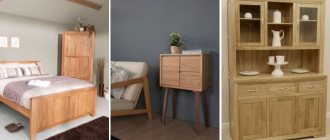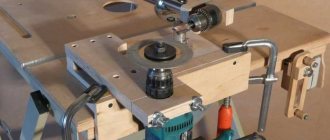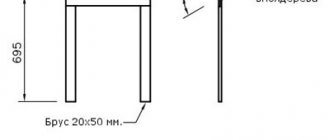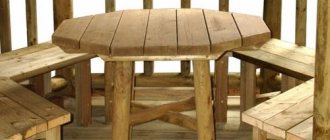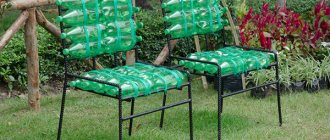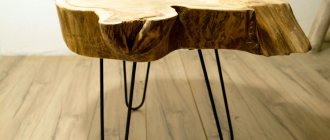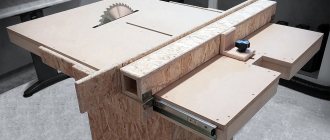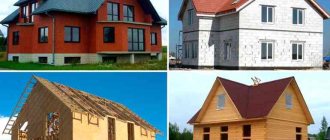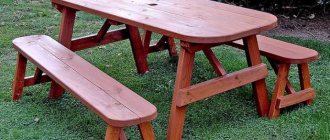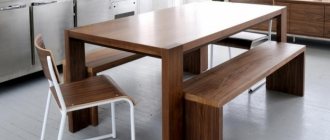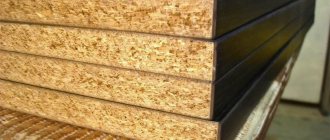For a home workshop, if welding work is often carried out there, a small welding scaffold is simply necessary, thanks to which you can organize a comfortable workplace and at the same time save some space.
A table made of metal, in addition to being convenient for welding work, will also act as a grounding loop; in addition, a welding machine, electrodes and other auxiliary tools can be placed on its lower shelves.
Requirement for welding table
Any table designed for welding work, in addition to convenience, must also have complete safety for the welder, since the work uses a high current with a fairly high voltage. To do this, its design must meet the following requirements :
- A forced exhaust must be equipped above the table to remove welding gases and dust from the welding area to the street.
- It is recommended to install a snail-mounted exhaust fan at a low height from the floor.
- If possible, it is advisable to make the edging of the tabletop from a copper strip. It is very convenient to knock off the coating for the electrode when igniting the arc.
- Be sure to install local illumination of the work area. It is recommended to use a voltage of 36 V for the backlight; a step-down transformer is specially used for this.
- Under the tabletop there should be shelves or special cassettes for storing electrodes and various auxiliary tools (wire brush, chisel, hammers, etc.).
- There should be a closed compartment for storing equipment that is used on rare occasions.
And the most basic requirement is that its design should not use or store flammable materials that release toxic substances when heated.
Briefly about the main thing
From my own experience, I know that even a not very experienced welder will not have any difficulty in welding the parts himself when assembling a welding table. None of the rules will prohibit adding or removing structural elements, if none of the drawings are suitable, or creating a device for your room and working conditions.
It is important not to neglect safety precautions, remember that we are working with flammable materials, so the table must be made of metal, the height suitable for the height of the master.
Question
Write in the comments what you think - should you make a welding table yourself in order to immediately adjust it to your needs, or is it better to buy a ready-made one?
Welding table design
There are two types of tables for the production of welding work for home workshops - these are ordinary, very simple tables for periodic welding of medium complexity and semi-professional assembly and welding tables on which more complex tasks are performed.
In terms of ease of use, the following requirements are imposed on the table:
- The height of the table should not be lower or higher than the limits of 700 - 850 mm.
- The minimum recommended dimensions of the working surface should be 800×1000 mm.
- The height of the table with a protective screen from welding rays must be at least 1400 mm.
Simple table for welding work
It is durable, easy to assemble and has a fairly convenient design for the welder to work with. Its design consists of a rigid frame , which is welded from metal and consists of four steel racks made of angle or profile pipes welded together. Along the lower part, at a height of approximately 200 mm from the floor, the racks are welded with corners, and on top they are welded to a strong frame on which the metal tabletop is located.
The metal tabletop may have special grooves for fastening the workpieces to be welded.
On the steel frame on which the tabletop is located, it is advisable to weld brackets for the welding wire, and it is recommended to place a shallow tray under the tabletop to collect dust and scale.
On the left or right side there may be a cabinet with several compartments for storing various tools. The remaining space is suitable for temporary storage of larger equipment.
It is advisable to weld a stand next to the water container.
Semi-professional welding table
This is already a rather complex design of an assembly and welding table with additional equipment. The ergonomic properties of such tables are practically no different from conventional ones, but they provide for the installation of additional equipment for milling, drilling and other metalworking operations. Tables can also be equipped with built-in ventilation systems.
For the rigidity of the entire structure, table legs are often firmly attached to the floor with anchor bolts or a concrete screed.
An important feature of these tables is the ability to rotate the working platform, thanks to which the welder can apply welds to the parts being welded from one working point.
Assembly and welding tables are often equipped with a quick-release bench vice, a set of different sizes of clamps and rotary attachments for installing a welding machine.
Table selection criteria
Protective screens from welding beams, ventilation ducts and other facing materials of the working area must be made of non-combustible materials. If earlier asbestos fabric was used for this, now modern materials Supersil or basalt cardboard are used.
For the rigidity of the entire structure, its mass must be at least 180 - 200 kg.
The lighting of the working area should be adjusted so that it does not create glare that interferes with the work of the welder (the glass of welding helmets practically does not absorb it).
The design must have a rotating mechanism for the working platform and built-in ventilation.
What it is
A welding table is a welder's workplace designed for fixing workpieces in the required position and performing welding work.
The name “table” in this case is arbitrary - it is, rather, a stand equipped with a lot of additional elements. There are tables of a solid type, but stands that resemble frames are more often used. They are more convenient, since sparks and drops of molten metal do not remain on the surface, but fall to the floor. they do not interfere with work and do not require constant cleaning of the table surface. In addition, they can be removed from the floor only once a day, and not every 20-30 minutes.
The material for manufacturing a welding table can only be steel. This is an important point, since the “ground” from the welding machine is connected to the table. When the workpiece is fixed on the table, it is automatically attached to the zero, which simplifies the work and avoids the need to constantly attach the zero using a clamp.
Materials and components
To make the table, a variety of materials are used in the form of steel angles, profile pipes, small channels and I-beams with rolled sheets. The main condition for it is stability and the ability to withstand the heavy weight of the workpieces processed on it.
Advice on material selection
For high strength, table stands are best made from a profile pipe with a minimum cross-section of 60×60×2 mm or a corner 63×63×4 mm.
It is advisable to make the working surface (tabletop) from a channel or corner mounted on one of the edges with the plane facing up. There should be a gap between the tabletop parts for clamps and other fastening tools that will, if necessary, secure the workpieces to be welded.
Auxiliary structures , with which you can increase the working surface area, are best made from profile pipes, as they are lighter in weight than steel angles.
It is also recommended to make the frame of the protective screen from a profile pipe and sheath it with thin sheet metal. It is advisable to make the screen with side sides.
Set of additional tools
To create the most comfortable working conditions, it is recommended to purchase an additional set of tools with functions for securely fixing the parts to be welded on the workbench with the ability to quickly change their spatial position. They must have strength and resistance to sudden temperature changes.
Such tools include clamps , with the help of which workpieces can be attached to each other or to the work table.
Clamps. Their function is almost the same as that of clamps, but they are more widely used. Thanks to them, you can set a certain angle and fix more complex connections between workpieces.
Magnetic base. Recommended for fixing small workpieces that cannot be secured with other mechanical devices.
DIY welding table drawings
The problem with making your own welding table is that there is very little information about such designs at the moment. If we take models made for industrial purposes as a basis, then their drawings are quite complex for use in home workshops, and many functions cannot be used at all. An alternative could be the simplest drawing, which you can simply modify and improve yourself.
The simplest and most affordable version of the table , which you can quickly and easily make with your own hands, modifying it yourself.
Which type should I choose?
A welding table is a type of equipment designed to organize a convenient and ergonomic workplace. Each person needs a table created according to individual parameters. One should not rely on generally accepted standards in this matter, since they do not take into account the individual needs of a person. For example, the location of lighting and ventilation is designed for the average person. If the master is left-handed, he will have to mirror the working drawing.
In addition, other factors must be taken into account:
- height;
- specifics of the upcoming work;
- degree of table mobility (stationary or mobile);
- lighting conditions;
- possibility of tilting the tabletop.
Before drawing up an assembly drawing, you need to carefully consider all these issues, calculate the dimensions of the table, decide where and how to install additional equipment and containers for storing tools, consumables, templates and clamps.
You should not waste time on drawing up a project - it will pay off many times over later.
Making a welding table
As an example of manufacturing, you can take a structure for welding work, made of metal profiled pipes and a steel angle. Naturally, during manufacturing you can use other sizes, materials and change the geometric shapes of the table itself.
Making a countertop
It is not recommended to make the tabletop from solid fabric. Its surface is welded from a profile pipe 60x40x2 mm (along the perimeter). The internal grille is made of a profile with a cross-section of 30×30×1.2 mm (8 or 10 channels can be used instead).
Pipe blanks are cut using a grinder, and the ends are cleaned of burrs. First of all, the outer frame is welded, which should have clearly identical diagonals.
Internal profiles are cut along the opening of the manufactured frame and inserted into its middle (the channels are laid on the frame) at a distance of 30-50 mm from each other, after which all welds are cleaned with a grinder.
Handles for the design of the welding table may be needed for ease of moving it to a new location. They are made from round reinforcement with a diameter of 12-14 mm, have a U-shape and are welded on both sides to the bottom of the tabletop.
Table legs
Four legs for the table are cut from a round pipe with a diameter of 50 mm (or from a square pipe 50x50 mm). Their length should be approximately 760 mm. The cut out posts are welded to the corners of the previously made table top.
After the legs are welded to the tabletop, additional strapping is made along the bottom of the racks to enhance the rigidity of the entire structure. To do this, stepping back from the lower end of the racks by approximately 200-300 mm, the legs are welded together with an angle section of 30×30 or 40×40 mm. The corner is welded with its flat side towards the bottom of the racks. A shelf made of chipboard or thick plywood will be placed in the middle of the corner to store various welding tools and the machine itself.
When welding the legs to the table top, it is important to prevent them from skewing. They must connect to the frame at a precise 90 degrees. To ensure such an even angle, you must use a metal square and a tape measure.
It is advisable to weld wheels to the racks for ease of moving the table, but this is only the case when it has to be rolled frequently. If it will be stationary, it is better not to use them, since the table will be unstable during operation, and it will be necessary to make additional brake mounts for the wheels.
Several hooks are welded to the table posts for storing the welding cable and holder for other devices. They are made from smooth wire with a diameter of 6-8 mm or ordinary nails 100-150 mm long. The nails are simply bent and welded to the outside of the posts.
Protective box
The box is welded under the tabletop to the racks at a slight slope. It is made of metal sheet and has small sides. Its function is to collect small debris, scale and slag knocked off the welds. At the same time, it protects against the same waste getting on the tools and devices that are located on the lower shelf, laid on the frame of the racks.
It is best to store tools in a special box made of chipboard or sheet metal. It would be best if instead there was a bedside table with several shelves on which you can sort the tools.
Main stages of production
If you put a drawing of the product in front of you, the whole process of how to make a welding table will become clear.
Source vmasshtabe.ru
The main activities consist of assembling:
- countertops;
- frame;
- protective box;
- waste tray, shelves and drawers.
All elements must be secured and installed in the required areas:
- weld legs, threaded supports;
- perform the bottom trim;
- install rack amplifiers;
- fix the support platforms.
When the structure is assembled, the welding seams must be sanded and all surfaces painted.
Safety when performing welding work
- Any metal welding work should be carried out only in rooms that are well ventilated or have equipment with an exhaust ventilation system.
- During work, you must use all personal protective equipment necessary for the welder. These include special non-flammable clothing, shoes, leather or canvas gloves, a welding mask or shield, and in some cases a respirator (when welding galvanized metal).
- All welding cable joints must be insulated and their insulation must not be damaged. If damage is detected during visual inspection, it must be insulated immediately.
- There should not be any flammable materials or substances in the workplace.
Photo
Taking into account the tasks set, the materials used and creative impulses, you can even get the following results:
